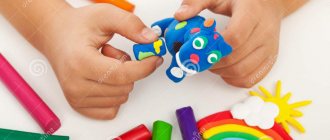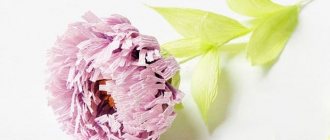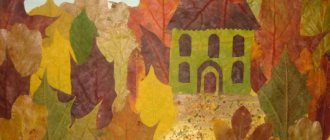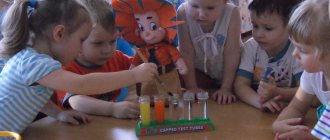Work program for the senior group
Productive imagination develops, the ability to perceive and imagine various worlds based on verbal descriptions, for example, space, space travel, aliens, a princess’s castle, events, wizards, etc.
These achievements are embodied in children's games, theatrical activities, drawings, and children's stories. Drawing is a favorite activity of older preschoolers; they devote a lot of time to it. Children are happy to show their drawings to each other, discuss their contents, exchange opinions, love to organize exhibitions of drawings, and are proud of their successes.
The subject of special attention of the teacher is the cognitive development of older preschoolers, their cognitive activity. Children use different ways of cognition: observation and introspection, logical methods (comparison, analysis, generalization, seriation, classification), simple measurements, experimenting with natural and man-made objects. Under the guidance of a teacher, six-year-olds engage in search activities, accept and independently set cognitive tasks, make assumptions about the causes and results of observed phenomena, use various verification methods: experiments, heuristic reasoning, long-term comparative observations, and independently make small discoveries.
Children's experimentation is important not only for the development of cognitive processes and mental operations, but also for the formation of independence, goal setting, and the ability to transform objects and phenomena to achieve a certain result. The process of independent exploration of new objects captivates preschoolers especially strongly when they can not only examine and touch these objects, but also transform and change them in order to understand internal connections and relationships.
An effective means of developing cognitive interests can be the creation of a mini-museum in a group. Any item in a mini-museum can suggest a topic for an interesting conversation. For example, in the mini-museum “Russian Izba” the exhibits are items of peasant life of the 19th-20th centuries: household utensils, pottery, spinning wheels, charcoal irons, homemade tablecloths and towels, baskets, boxes and much more.
In such a museum, children are not just passive spectators, but creators of the exhibition. After all, a museum is the result of communication and joint work of a teacher, children and their parents.
The development of cognitive interests is facilitated by the use of the project method. It gives the child the opportunity to experiment, synthesize acquired knowledge, develop creativity and communication skills. For example, the “Origin of Paper” project expands children’s understanding of the types, properties, and methods of paper production, gives them the opportunity to make paper themselves, experiment with different types of paper, and choose a more suitable type for drawing, creating a design, or packaging. The teacher expands the possibilities of knowledge of his hometown, region, country. It is good to include in the group the coat of arms of the city in which the children live, the coat of arms and the flag of Russia. You can hang up a map, mark the location of the kindergarten and the places the children visited with their parents, and attach photographs and children’s drawings nearby. Together with your children, you can make layouts that reflect the content that preschoolers are learning about: the north of the country, the nature of the central part of Russia, etc.
Long-term planning of educational activities in the senior group (according to the “Childhood” program)
| 26.03.15 | Road safety | V.N. Volchkova p.182 |
| 30.03.15 | Plants are the lungs of the Earth | V. N. Volchkova p.84 |
| 06.04.15 | How to behave at the circus? | V.N. Volchkova p.145 |
| 09.04.15 | Nature of the native land | abstract |
| 13.04.15 | Where do plants like to live? | V.N.Volchkova p.87 |
| 20.04.15 | Who shoes and dresses us? | V.N. Volchkova p.33 |
| 23.04.15 | Poisonous mushrooms and berries | V.N. Volchkova p.198 |
| 27.04.15 | Who enjoys spring the most? | V.N. Volchkova p.97 |
| 07.05.15 | Travel along the Kuban River | T.P. Khlopova p.69 |
| 18.05.15 | Artificial materials are needed | V. N. Volchkova p.98 |
| 21.05.15 | Safety in nature | V.N. Volchkova p.195 |
| 25.05.15 | Earth is our common home | V.N. Volchkova p.119 |
Bibliography.
Mathematics. Senior group. Lesson developments. Parts I and IIAuthor: Zhukova R.A. Publisher: ITD "Corypheus" 2009
Volchkova V.N., Stepanova N.V.: Lesson notes for the senior group of kindergarten. Speech development. Practical guide for educators and methodologists of preschool educational institutions. - Voronezh: TC “Teacher”, 2006
D.G. Shumaeva: How to be able to read well: Teaching preschoolers to read: Program summary. St. Petersburg: Aksident, 1998
Volchkova V.N., Stepanova N.V.: Lesson notes for the senior group of kindergarten. Cognitive development. Practical guide for educators and methodologists of preschool educational institutions. - Voronezh: TC “Teacher”, 2008
Volchkova V.N., Stepanova N.V.: Lesson notes for the senior group of kindergarten. Ecology. Practical guide for educators and methodologists of preschool educational institutions. - Voronezh: TC “Teacher”, 2008.
Volchkova V.N., Stepanova N.V.: Lesson notes for the senior group of kindergarten. ISO. Practical guide for educators and methodologists of preschool educational institutions. - Voronezh: TC “Teacher”, 2008
Ushakova O.S., Gavrish N.V. We introduce literature to children aged 5-7 years. Lesson notes.- M.: TC Sfera, 2010.-224 p.- (Speech development).
A collection of articles and materials dedicated to the anniversary of the village of Temizhbekskaya. 200 years of the village of Temizhbek.
Lykova I.A. Visual activities in kindergarten: planning, notes, classes, methodological recommendations. Senior group. - M.: Karapuz-Didaktik, 2007.
Lyudmila Kutsakova: Design and artistic work in kindergarten: Program and lesson notes Publisher: Sfera, 2008
E. Gulyants, I. Bazik, What can be made from natural materials Publisher: Moscow “Prosveshcheniye” Year: 1991
Irina Novikova: Paper construction in kindergarten. Publisher: Academy of Development, 2010
N.N. Leonova Artistic and aesthetic development of children in the senior group of preschool educational institutions. Long-term planning, notes. - St. Petersburg: Publishing House “Childhood-Press” LLC, 2014
T.M. Bondarenko: Complex classes in the senior group of kindergarten. Practical guide for educators and methodologists of preschool educational institutions. - Voronezh: TC “Teacher”, 2007
The Development program is focused on developing children's mental abilities and creativity. Classes on speech development and familiarization with fiction include three main areas: 1) familiarization with fiction (reading poetry, fairy tales, stories, conversations about what you read, play improvisations based on the plots of the works you read); 2) mastering special means of literary and speech activity (means of artistic expression, development of the sound side of speech); 3) development of cognitive abilities based on familiarization with children's fiction. Mastery of different aspects of speech occurs in the context of familiarization with works of art. The idea of the unity of sensory, mental and speech development is clearly expressed and implemented. In the middle group, preparation for learning to read and write is set as an independent task, and in the senior and preparatory groups - learning to read (Development Program. (Basic provisions). - M., 1994.)
The “Childhood” program contains special sections devoted to the tasks and content of children’s speech development and familiarization with fiction: “Developing children’s speech” and “Child and the book.” These sections contain for each group a description of the traditionally distinguished tasks: the development of coherent speech, vocabulary, grammatical structure, and the education of a sound culture of speech. The program is distinguished by the fact that at the end of the sections, criteria are proposed for assessing the level of speech development. It is especially important that it clearly identifies (in the form of separate chapters) and meaningfully defines speech skills in different types of activities.
“The program for the development of speech for preschool children in kindergarten” was prepared on the basis of many years of research conducted in the speech development laboratory of the Institute of Preschool Education under the leadership of F. A. Sokhin and O. S. Ushakova. It reveals the theoretical foundations and directions of work on the development of children's speech skills. The program is based on an integrated approach to speech development in the classroom, the relationship of different speech tasks with the leading role of the development of coherent speech. Within each task, priority lines are identified that are important for the development of coherent speech and verbal communication. Particular emphasis is placed on the formation in children of ideas about the structure of a coherent utterance, about the methods of connection between individual phrases and its parts. The content of the tasks is presented by age groups. This material is preceded by a description of the speech development of children. The program significantly deepens, complements and clarifies the standard program developed earlier in the same laboratory (See: Ushakova O. S. Program for the development of speech for preschool children in kindergarten. - M., 1994.)
Review of environmental education programs for preschool children
Review of environmental education programs for preschool children
The initial link of the general concept of continuous environmental education is the sphere of preschool education. It is at the stage of preschool childhood that the child receives emotional impressions about nature, accumulates ideas about different forms of life, i.e. the fundamental principles of ecological thinking and consciousness are formed in him, and the initial elements of ecological culture are laid.
The content of the pedagogical process in preschool educational institutions is regulated by comprehensive and partial programs that provide one or more areas of development; Among the latter, environmental ones also stand out.
The comprehensive programs include “Rainbow”, “Childhood”, “Development”, “Origins”, “Kindergarten - a house of joy”, “Krokha”. The Ministry has also approved a number of partial environmental programs: “Seven Flowers”, “Nature and the Artist”, “Our Home is Nature”, “The World Around Us”, “Cobweb”, “Young Ecologist”.
All programs are focused on a new concept of raising preschool children, which is based on a personality-oriented model of education and an individual approach to the development of a child’s intellectual and artistic abilities. Let's consider the content of some programs with an environmental focus.
“Krokha” is a program for raising young children in families and kindergartens. Contains a section on environmental education. E.F. Terentyeva (author of the section) highlights a number of circumstances that adults can use to introduce children to nature. If there are plants, animals in the room (at home or in kindergarten), adults can involve children in observation and joint care. A diverse world opens up to children from the window of the room - an adult can show a child a lot. For the purpose of environmental education, observation of flora and fauna is organized at different times of the year, and games are played with children in nature and with natural materials.
The “Natural World” subsection of the “Rainbow” program is a component of the educational section of children, within which they are given information, develop cognitive processes, form an attitude towards the world around them - all together, according to T.I. Grizik creates in children an image of the world, a holistic idea of the environment. The methodological material of the program contains a large number of lessons devoted to plants, animals, planet Earth and the structure of the solar system. The subject of the classes involves the inclusion of geographical material and information about other countries (the nature of Africa, dinosaurs, etc.), based on seasonal observations, “portraits” of each month are compiled, children are introduced to the history of watches, calendars, and globes. The program includes educational facts about the world and nature, but they are not aimed at developing a value-based attitude towards it in children.
“Childhood” is a program for the multifaceted development of preschoolers with an environmental focus, created by the teaching staff of St. Petersburg Pedagogical University. It contains a section “A child discovers the world of nature,” which involves introducing children to various phenomena from the life of plants, animals, and their communities. The program includes four content blocks for each age: information about plants and animals as representatives of living things in the natural world (features of external structure and vital functions, the connection of living beings with their environment, their uniqueness); mechanisms of adaptive relationship between the life of organisms and their environment (properties of various environments, ideas about groups of animals living in a homogeneous environment); knowledge about the growth, development and reproduction of plants and animals familiar to children (ideas about successive changes in organisms, the cyclical nature of the process”; knowledge of an ecosystem nature (children get acquainted with plants and animals living in the same community, their interdependence).
N.I. Kondratieva developed a partial program for environmental education for children “We”. ABC of ecology". The content is based on an expanding understanding of a living organism. In all sections, knowledge acts as a leading factor in the development of environmental consciousness in children. According to the author, it is consciousness that allows an older preschooler to understand the role of man on Earth and to realize that he is a part of nature. The program involves traditional types of children's activities - observation, modeling, work in nature, play, creativity and design. Environmental protection activities, which can be carried out by older preschoolers in all seasons of the year, are of particular importance.
“Origins” is another comprehensive program created by the psychological and pedagogical team of researchers named after. A.V. Zaporozhets. The authors consider it as basic, aimed at the comprehensive, full development of the child, the formation of his unique (including creative) abilities and their development to the level of age-related capabilities and requirements of modern society. The program includes a section “Knowledge of the surrounding world.”
The main goal of the environmental program “Our Home is Nature” is to educate from the first years of life a humane, socially active, creative personality, capable of understanding and loving the world around us, nature and treating them with care. Particular attention is paid to the formation of a holistic view of nature and man’s place in it. Great importance is attached to the moral aspect: the development of ideas about the intrinsic value of nature, an emotional positive attitude towards it, the development of the first skills of environmentally literate and safe behavior in nature and everyday life. Children acquire initial skills that allow them to participate in feasible practical activities to protect the nature of their native land. The program contains a basic component, which is specified taking into account local conditions. It consists of a number of blocks, each of which includes a set of topics. In the first block, “Me and Nature,” children become familiar with the various components of the environment. Subsequent blocks provide additional information about each component (“Air”, “Water”, etc.). They then consider them in relation to each other. The final block “Man and Nature” is general in relation to the previous ones.
The “Young Ecologist” program (author S.N. Nikolaeva), aimed at introducing preschoolers to nature and environmental education, incorporated the results of research by scientists in the field of child psychology and pedagogy (A.V. Zaporozhets, L.A. Venger, V. S. Mukhina, N.N. Poddyakova, P.G. Samorukova, etc.). The beginning of work on environmental education of children in kindergarten is the correct organization of the natural zone, that part of the premises and area of the preschool institution where plants grow and any animals are kept.
Thus, at the present stage there is a wide variety of environmental education programs for preschoolers. Each of them offers different forms of organizing environmental education, but all are aimed at developing knowledge about the environment, instilling in children a humane attitude towards nature and awareness of themselves as a part of it.




